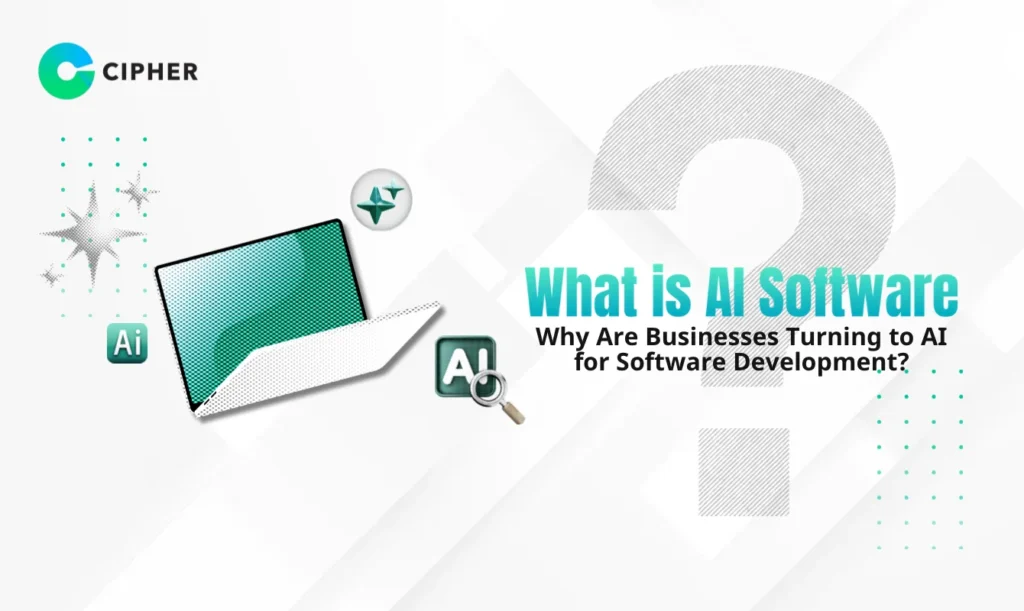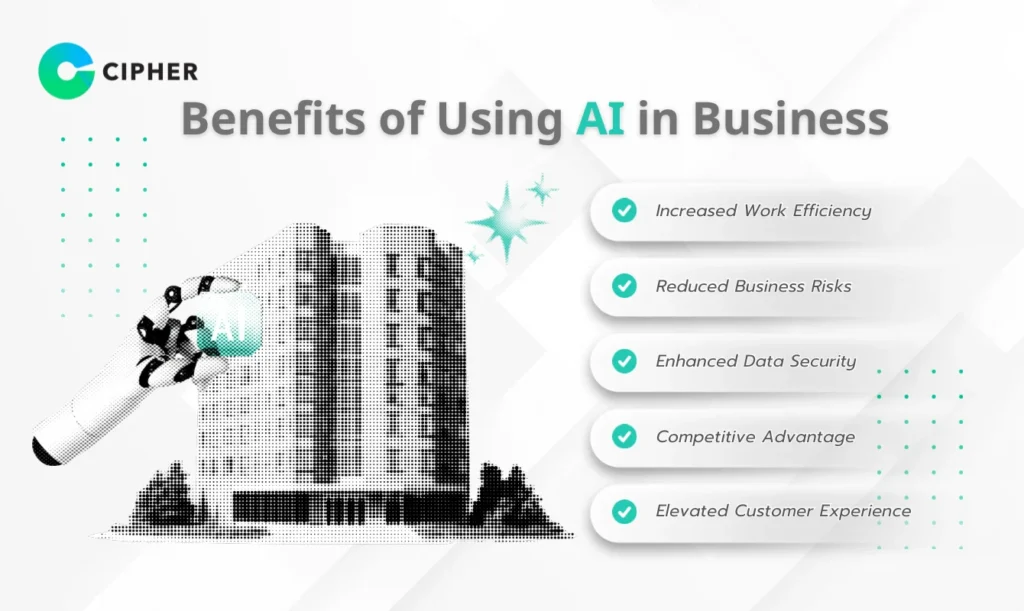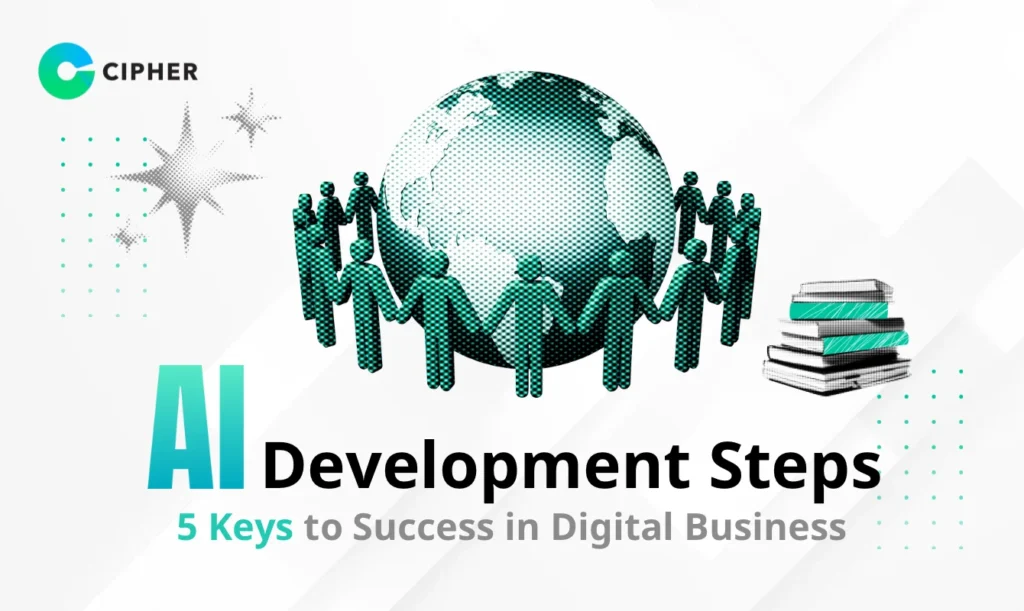Did you know that by 2025, organizations in Thailand have all planned to implement AI in their businesses? If you’re looking to elevate your business with AI technology but aren’t sure where to start, this article has the answers for you! CIPHER, experts in Software and Digital Marketing, will guide you through the AI development steps from beginning to implementation, ensuring your process of starting an AI project goes smoothly and successfully.
Table of Contents
What is AI Software?

AI Software or software that utilizes artificial intelligence refers to computer programs that can learn, analyze, and make decisions similar to humans through complex processing instructions, using techniques such as Machine Learning and Deep Learning.
Today, AI is no longer a distant concept! From self-driving cars to Chatbots that answer customer questions instead of staff, AI has become a part of our daily lives without us even realizing it, and is completely transforming the way businesses operate.
Why Are Businesses Turning to AI for Software Development?
In an era of vast amounts of data, processing and analyzing this information using traditional methods may no longer be sufficient. Businesses should consider using AI in business because:
- Businesses need speed in responding to rapidly changing markets
- Increased competition requires finding ways to improve efficiency and reduce costs
- Modern customers demand more personalized and tailored experiences
- There’s too much data for humans to process efficiently
Currently, businesses in Thailand are implementing AI for three main purposes: increasing production/service efficiency, improving internal organization management, and increasing revenue. With these reasons in mind, if you haven’t applied AI to your business yet, you might be several steps behind your competitors.
Benefits of Using AI in Business

Using AI in business isn’t just a passing trend, but a revolution in business operations that creates numerous benefits:
- Increased Work Efficiency: AI can handle repetitive tasks faster and more accurately than humans, allowing employees to focus on higher-value work. For example, using AI to read data from Bank Statements instead of having staff manually input the information.
- Reduced Business Risks: AI can analyze trends and predict risks in advance, allowing you to prepare appropriate responses in a timely manner.
- Enhanced Data Security: With systems for detecting data theft and abnormal behavior, AI helps protect important business and customer information.
- Competitive Advantage: AI helps analyze competitor behavior and market gaps, enabling more accurate strategic decisions.
- Elevated Customer Experience: From Chatbots that provide immediate responses at any time to recommendation systems that understand individual needs, AI helps customers feel specially cared for.
These are just some examples of the benefits AI offers businesses, not only solving current problems but also preparing businesses to face future challenges.
How to Plan AI Development Without Getting Lost from the Start
Before planning AI development, the most important thing is to understand that AI is not a magic solution that can solve all problems instantly. Good planning an AI project must start with asking important questions such as:
- What problem needs to be solved? Be clear about what AI will help solve, not just wanting AI because it’s trendy.
- Is there sufficient data? AI requires large amounts of data to learn. If there’s no data or the data is low quality, AI cannot work effectively.
- Are resources sufficient? Consider budget, personnel, and time.
- Should you develop in-house or hire experts? If your organization lacks AI skills, hiring AI developers might be a better option.
A key tip for planning AI development is “start small, scale fast.” Instead of attempting a large AI project immediately, start with small projects with high chances of success, such as using AI to analyze customer data first, then expanding to more complex systems. This approach not only reduces the risk of failure but also helps the team learn and gain experience, which will be very beneficial for larger projects in the future.
AI Development Steps for Organizations
1. Preparing Data for AI Creation
Preparing data for AI creation is the most important step and often takes the most time. Good data must be high quality, sufficient in quantity, and relevant to the problem you want to solve.
The data preparation process includes:
- Data Collection: Start by understanding the problem you want to solve, then determine what data you need, and plan how to collect and gather this data.
- Data Cleaning: Collected data may be incomplete, such as duplicate data, missing data, or erroneous data, so it needs to be cleaned before use.
- Transforming Data for Use: Different types of data require different handling, such as:
- Text: May need to be converted from PDF using OCR technology
- Images: Need to check clarity and size
- Structured data: Need to handle inconsistencies, such as “Bangkok,” “BKK,” “Bangkok”
- Data Splitting for Use: Divide the data into 3 parts:
- Training Set
- Validation Set
- Test Set
Common problems at this stage include insufficient data or data scattered across multiple sources, which may require significant time and resources to gather and manage.
2. Choosing the Right Technology and Tools
After preparing the data, the next step is to select appropriate technology and tools for your project, considering various factors:
- Type of Problem: Different problems require different AI technologies, such as:
- Image analysis: Use Computer Vision
- Text or voice analysis: Use Natural Language Processing (NLP)
- Numerical data analysis: Use general Data Analytics & Machine Learning
- Data Size: Large datasets may require special tools for distributed computing
- Team Readiness: Choose technology that your team has expertise in or can learn easily
- Budget and Time: Some technologies may be expensive or require long development times
Popular tools for AI software development currently include:
- Programming languages: Python, R, Julia
- Frameworks for Machine Learning: TensorFlow, PyTorch, Scikit-learn
- Data management tools: Pandas, NumPy
- Cloud platforms: AWS, Google Cloud, Microsoft Azure
Choosing the right technology from the beginning will save time and resources in the long run, as changing technology midway may require starting over completely.
3. Developing and Testing the AI Model
Once you have the data and tools ready, the next step is to develop the AI model, which is the heart of the system. This involves:
- Creating a Baseline Model: Start with a basic model to see how well it can solve the problem
- Training the Model: Use the training data set to allow the model to learn
- Fine-tuning the Model: Use the validation data set to adjust the model’s parameters for maximum efficiency
- Testing the Model: Use the test data set, which the model has never seen before, to evaluate its actual performance
Testing is a crucial step that will indicate whether your model is ready for actual use. Performance should be measured from multiple dimensions, such as:
- Accuracy
- Processing speed
- Ability to work with new data
- Long-term stability
If the test results are not satisfactory, you may need to go back and improve previous steps, such as collecting more data, adjusting the data preparation method, or changing the technology used.
4. Building the System and Integrating with Existing Systems
Having a good AI model alone is not enough. You need to build AI systems for business that can be practically used, which means developing software or applications that users can access and connecting them with the organization’s existing systems.
Important steps in building an AI system include:
- Designing the User Interface: It must be easy to use, uncomplicated, and suitable for the user group
- Developing APIs: To allow the AI system to communicate with other systems
- Integration with Existing Systems: Both new and existing systems may need to be adjusted to work together smoothly
- System Deployment: Choose the appropriate installation format, such as on the organization’s server or in the cloud
- Preparing Users: Train employees to understand how to use the new system and explain the benefits
Challenges at this stage often arise from old and new systems not being able to work together smoothly, or users not accepting the change. Good planning and clear communication will help reduce these problems.
5. Monitoring, Analyzing Results, and Continuous Improvement
AI development is not a one-time task but requires ongoing monitoring, analysis, and improvement to ensure the system remains effective and meets business needs.
Important activities at this stage include:
- Performance Monitoring: Check if the AI model is still working well; if performance decreases, improvements may be needed
- Collecting User Feedback: Gather opinions from users to improve the system
- Model Updating: When new data becomes available, it should be used to train the model again for improved accuracy
- Expanding the Scope of Use: When the system starts to stabilize, consider expanding its use to other parts of the organization
Continuous monitoring and improvement will ensure that AI investments are worthwhile in the long term and help organizations adapt to market and technology changes.
Steps to Hire an AI Development Company: What Organizations Should Know
Set Clear Briefs: Goals + Available Data
Clear communication of requirements is key to the success of an AI project. You should prepare:
- Clear Goals and Objectives: Specify what problem you want to solve and what results you expect
- Available Data and Resources: Specify what data you have, how it’s stored, and how much there is
- Limitations and Special Conditions: Such as budget, timeline, or security requirements
- Success Criteria: Define metrics to evaluate whether the project is successful
A clear brief will help the development company understand your needs and propose appropriate development approaches.
Check Portfolio and Company Experience
Not all companies have the same expertise in AI development. You should consider:
- Past Work: See if the company has done projects similar to yours and what their results were like
- Experience in Your Industry: Companies that understand your business can provide more targeted recommendations
- Team and Expertise: Check if the company has a team with real AI expertise
- Reviews and Recommendations from Previous Clients: Ask for opinions from organizations that have used their services
CIPHER is one of the companies with expertise in IT Solution and Digital Marketing, with experience developing software systems for many leading Thai companies and partnering with global Online Marketing companies like HubSpot.
Ask About Working Methods and Delivery
To prevent problems that may arise during development, you should inquire about:
- Work Process: How does the company work and how will progress be reported?
- Timeline and Action Plan: How are timelines and sub-goals defined?
- Project Delivery: How will it be delivered and what quality assurance is there?
- Post-Delivery Support: Is there a service to maintain and improve the system after delivery?
- Knowledge Transfer: Will there be training for your team to use and maintain the system?
Understanding how the development company works will help you plan and prepare resources appropriately, as well as track progress efficiently.
Examples of AI Software That Meets Real Business Needs
Let’s look at examples of implementing AI in real businesses to see how AI development steps can lead to tangible results:
- Major Bank in Thailand: Developed an AI system for automated loan approval, starting with AI-OCR to extract data from Bank Statements and other financial documents, reducing the approval process from several days to just a few hours.
- Electronics Component Factory: Used Computer Vision to inspect product quality, detecting abnormalities 30% more accurately than humans and reducing costs from product recalls by more than 15 million baht per year.
- Large Retail Company: Developed a product recommendation system that analyzes customer buying behavior, increasing sales by 23% in the first 6 months of use.
- Private Hospital: Used AI to analyze lung X-rays to help screen COVID-19 patients, allowing doctors to diagnose more quickly and reducing the risk of infection for medical personnel.
It’s clear that AI is not just exciting technology but a tool that can create tangible business results, whether reducing costs, increasing revenue, or improving work efficiency.
Consult CIPHER Experts to Start Developing AI Software with Confidence
Planning AI development may seem complex and challenging, but you don’t have to face this challenge alone. CIPHER is ready to be your partner to help you navigate through all AI development steps smoothly.
With a high-quality and experienced team, CIPHER provides comprehensive AI and Digital Solution services, from consulting, planning, development, to post-installation system maintenance, which will help your organization get the most out of your AI investment.
CIPHER Services
CIPHER’s services cover all AI and Digital Marketing needs, including:
- Developing AI systems according to specific organizational needs
- Analyzing and designing AI solutions suitable for your business
- Providing consultation and planning strategies for Digital Transformation
- Developing and maintaining E-Commerce, Website, Mobile Application systems
We have experience in managing and developing systems for many leading national brands, giving us an understanding of the needs and professional management methods for all online forms and channels.
Conclusion
Starting an AI project may seem complex, but with clear AI development steps and good planning, your organization can create an AI system that meets your needs and creates real value for your business.
The most important thing is to start with a clear goal, have quality data, choose appropriate technology, and continuously monitor results. Whether you choose to develop it yourself or hire an AI development company like CIPHER, a basic understanding of AI development steps will help you control the project and get the expected results.
Remember, implementing AI in your organization is not a revolution that requires changing everything at once, but a process that gradually develops and grows along with your business. Start with small projects, build success, and expand to using AI in other areas.
Ready to begin your journey into the world of AI? CIPHER is ready to guide you!
Frequently Asked Questions
What are the AI development steps for organizations?
AI development for organizations typically consists of 5 main steps:
- Preparing data for AI creation
- Choosing appropriate technology
- Developing and testing the model
- Building the system and connecting with existing systems
- Monitoring and continuous improvement
If I don't have a Data Scientist or Developer team, can I start an AI project?
What data should be prepared before creating AI?
- Types of data relevant to the problem you want to solve
- Data should be sufficient in quantity and accurate
- Data must be ready to use, such as converted from PDF, verified images, or structured data suitable for AI
- Divide data into Training, Validation, and Test Sets





